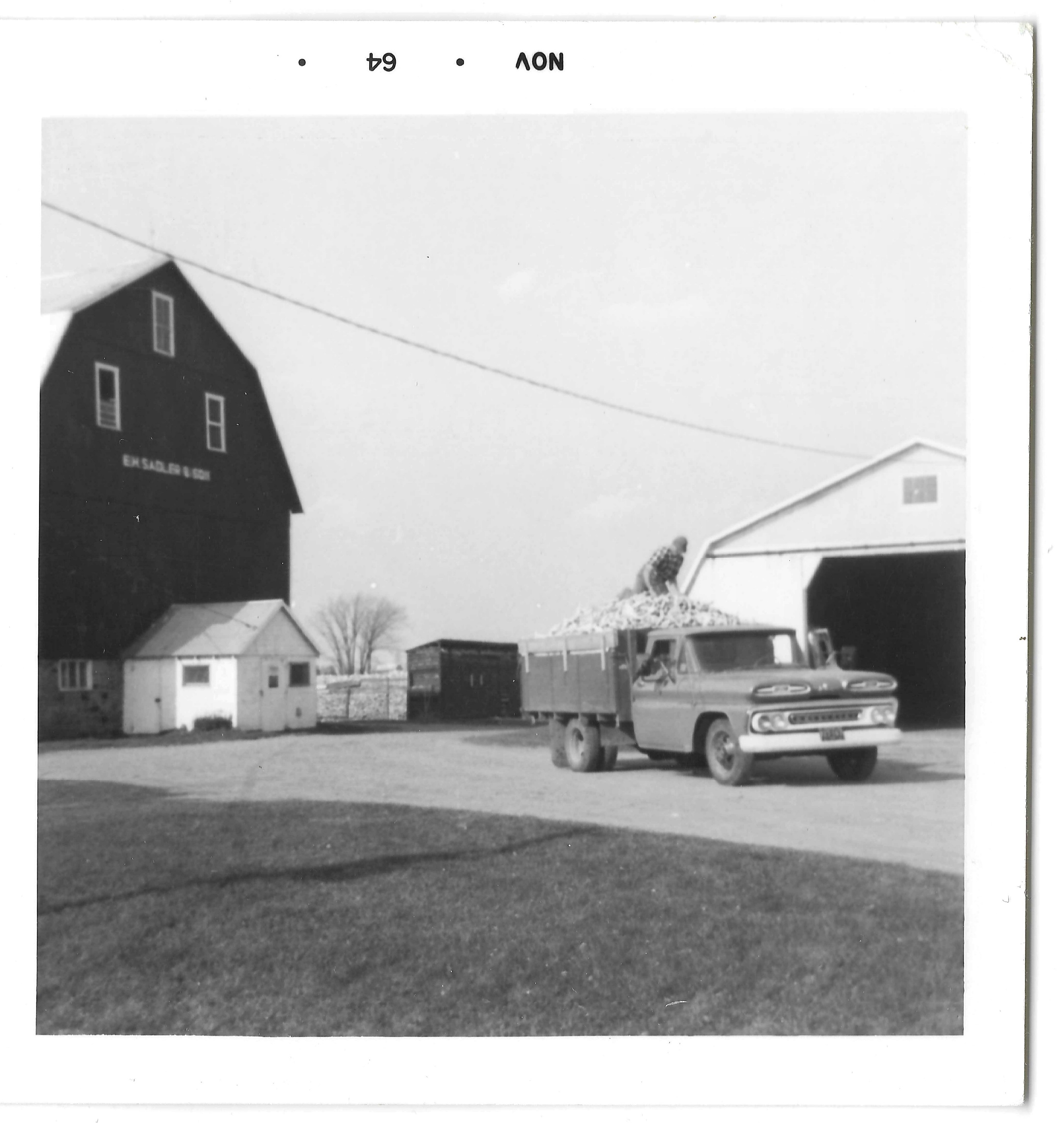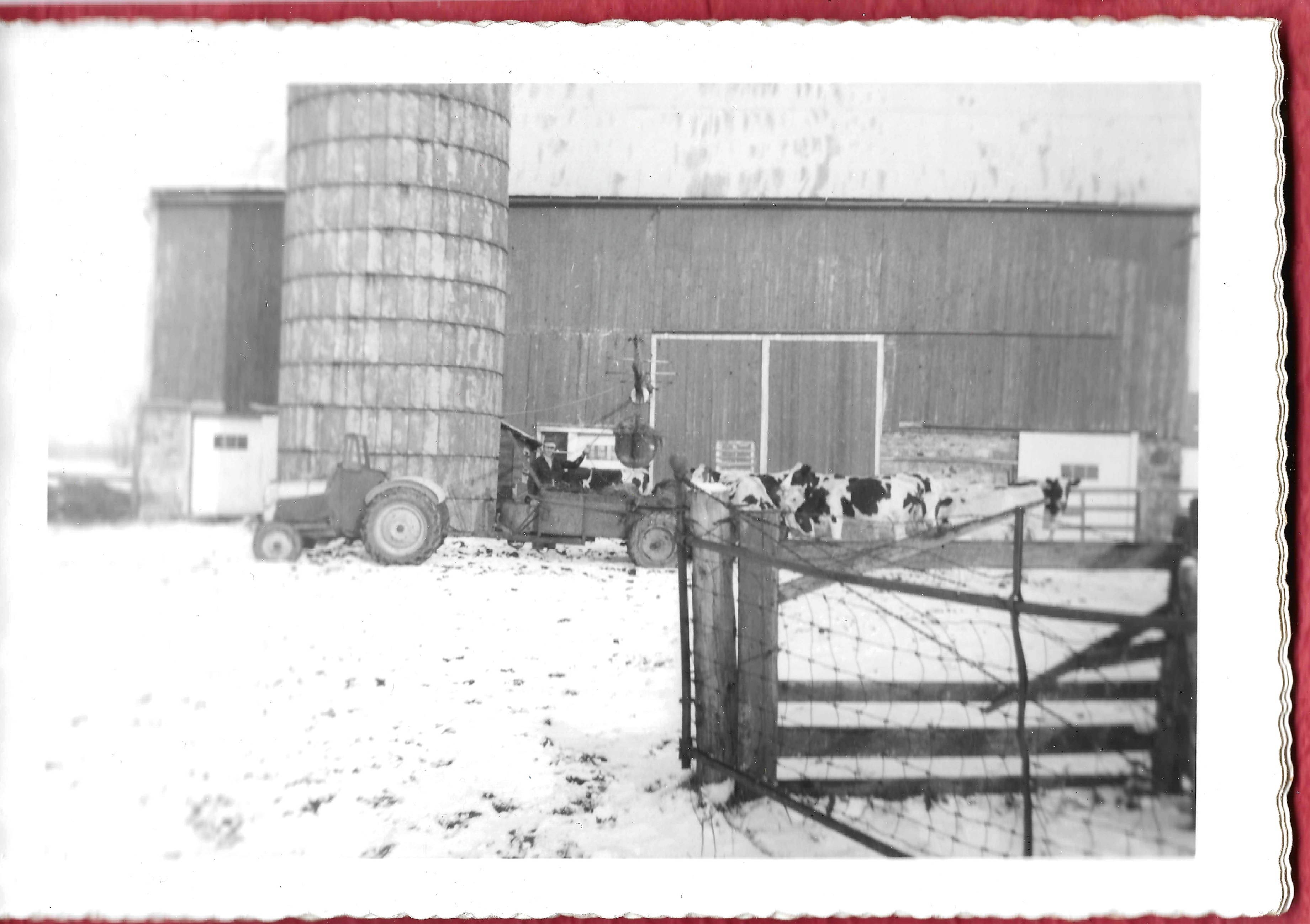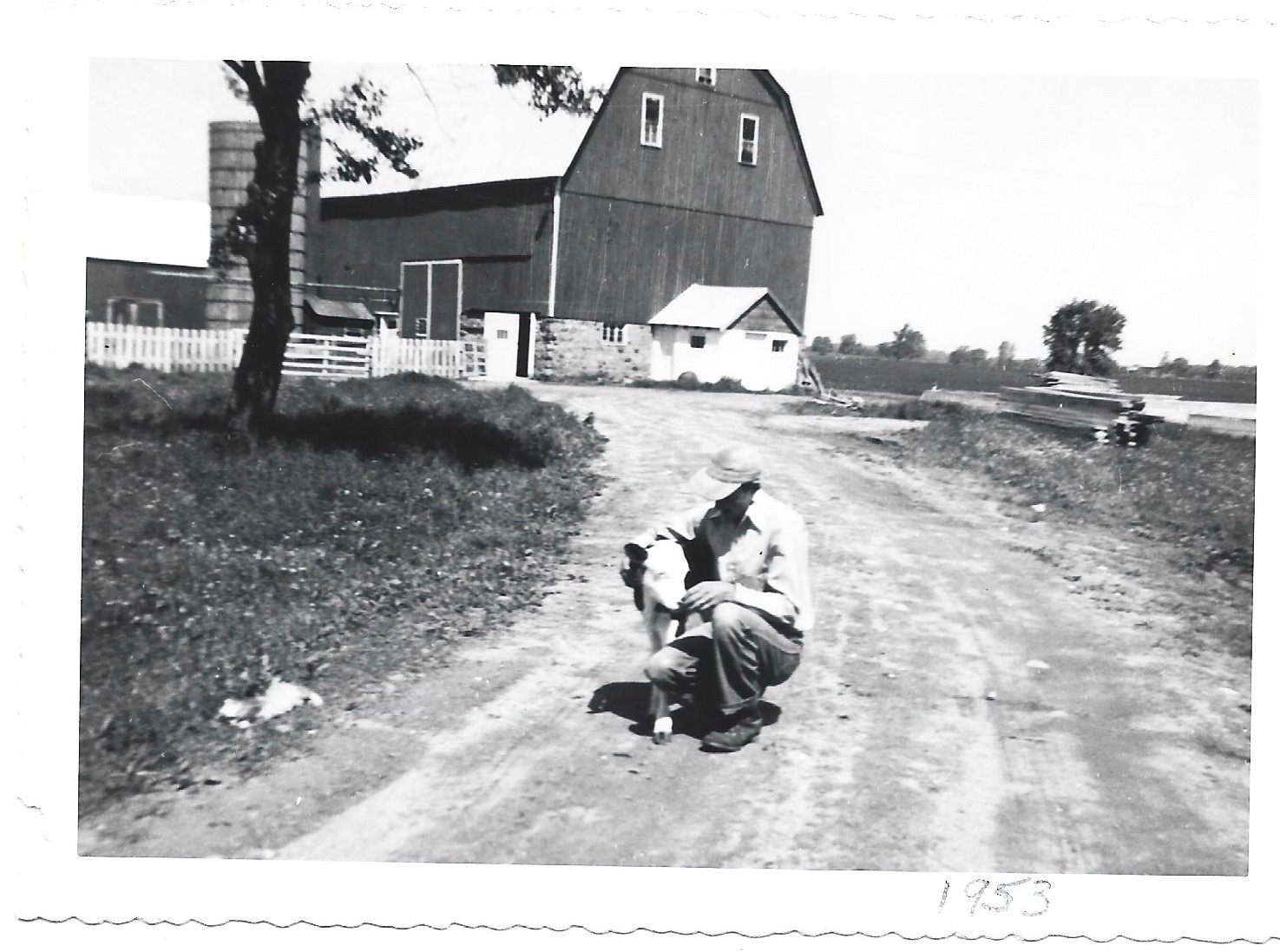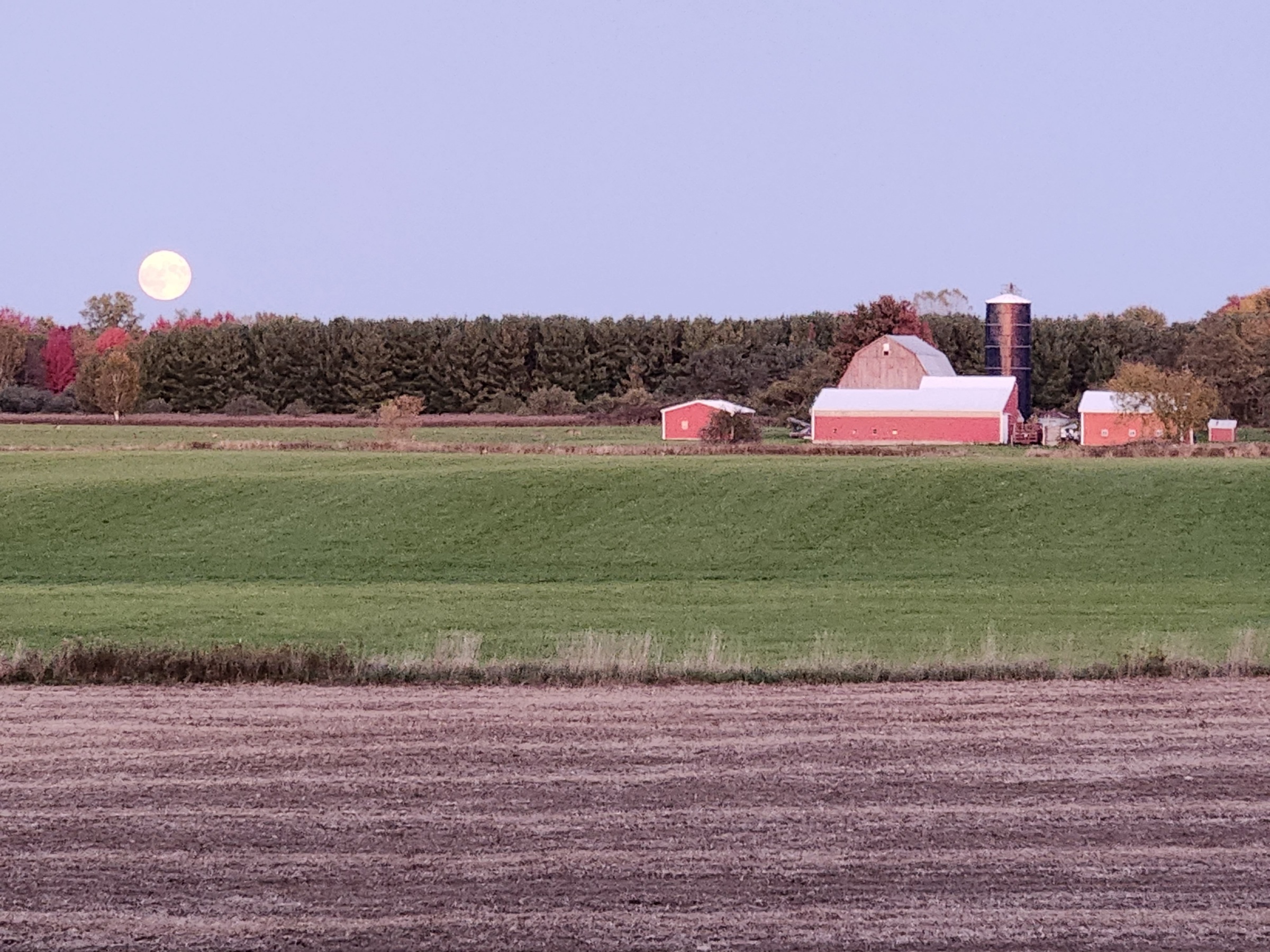This Old Barn- What would you do?
Printed From: Unofficial Allis
Category: Other Topics
Forum Name: Shops, Barns, Varmints, and Trucks
Forum Description: anything you want to talk about except politics
URL: https://www.allischalmers.com/forum/forum_posts.asp?TID=207457
Printed Date: 29 Dec 2025 at 5:28pm
Software Version: Web Wiz Forums 11.10 - http://www.webwizforums.com
Topic: This Old Barn- What would you do?
Posted By: Don(MI)
Subject: This Old Barn- What would you do?
Date Posted: 13 Jul 2025 at 4:56pm
|
So here's the deal. Growing up in my neighborhood, I never paid much attention to my Grandfathers Original Farm and Homestead property. He got divorced in the 80's and had to sell the farm, everything, including the farm home and barns. Because of this, I didn't really pay much attention to them and the fact was, when I grew up we went to grandpas other farmstead where he landed years later after everything settled out. That was "Grandpas farm" to me and my sister growing up in the 90's. Fast forward to Today. Because of the divorce, The Original home farm had 2 owners since then. The current owner, did put new steel roofs on the smaller barns and kept them up. But the Original Hip Roof barn, that is on the homestead needs work. The roof is not terrible, but probably needs refastened and new paint. And of course the sides of the barn needs new paint also. Here's where I'm at. Because I do really care about family history, If I actually won the lottery I would donate money to the current owner to repaint it and preserve it. I know things don't last forever, and I know it's just a barn. But boy...now that I'm older I would hate to see it fall down because of neglect. I know barns cost money to repair and fix. And it's probably cheaper to build a new steel Barn for storage. But the history is there. Take a look at these photos below. Just wishing on my part I guess, that I could actually do something to help. (No I'm not climbing on the roof to repaint it, I would not do well up there). What would you do? Would you talk to the current owner? See if there was another way to help? Maybe it's all foolishness on my part, just hate seeing another Barn go down over time. Let alone it's the family Barn with history... ------------- Galatians 5:22-24 "I got a pig at home in a pen and corn to feed him on, All I need is a pretty little girl to feed him when I'm gone!" |
Replies:
Posted By: Don(MI)
Date Posted: 13 Jul 2025 at 5:00pm
   That's my Grandfather in front of the Barn ------------- Galatians 5:22-24 "I got a pig at home in a pen and corn to feed him on, All I need is a pretty little girl to feed him when I'm gone!" |
Posted By: Don(MI)
Date Posted: 13 Jul 2025 at 5:03pm
 Currently Today ------------- Galatians 5:22-24 "I got a pig at home in a pen and corn to feed him on, All I need is a pretty little girl to feed him when I'm gone!" |
Posted By: KMAG
Date Posted: 13 Jul 2025 at 5:19pm
| Offer your labor to maintain barn - may make a good friend, and save barn. |
Posted By: Dorix
Date Posted: 13 Jul 2025 at 5:38pm
| Ask them if you can take pictures. Don't get me wrong I like old barns and hate seeing them come down, but if the currant owners aren't keeping them up anything you do will probably only be short term. I wish I had more pictures of the farms my grandparents grew up on. |
Posted By: DMiller
Date Posted: 14 Jul 2025 at 2:03am
|
Great Aunt and Uncle's farm now belongs to their only child, a daughter's girls, Barn has been gone several decades, Great Aunt's home she died in also gone since early 2000s. My Cousin's home was the old Schoolhouse they bought and converted into a Home is still there just mostly empty now where the Girls do come out and stay at times to leave the busy where they currently live behind for a few days. We have photos of that farm as they do when Great grandfather was staying there in the 1930s as Ben and Mable worked to keep it during the Depression. Grandmother and her other Sisters took tons of photos to make certain everyone of the family remembered those times. I have great memories as was a Youth working on the place, playing on the place and being a part of the Family that enjoyed the Place. Miss all my relatives deeply but time moves around us regardless how hard we attempt to remain in place.
|
Posted By: Ed (Ont)
Date Posted: 14 Jul 2025 at 2:36pm
That was a nice farm back in the day!! 
|
Posted By: jaybmiller
Date Posted: 14 Jul 2025 at 8:21pm
|
Talk to the owner, introduce yourself, show him pictures, ask if you could have 1st dibs if he decides to sell..... never hurts to ask. I've seen 7 of 8 barns 'leave the landscape' near me. Real shame, upsets me and I'm not a farmer...... ------------- 3 D-14s,A-C forklift, B-112 Kubota BX23S lil' TOOT( The Other Orange Tractor) Never burn your bridges, unless you can walk on water |
Posted By: BuckSkin
Date Posted: 15 Jul 2025 at 5:49am
|
That is a good-looking barn and appears it would be worth saving; however, most people, no matter how pure your intentions, don't like others meddling and resent it. If you truly want to save the barn, BUY IT. Not to nitpick; but, it is a very common mistake concerning those style roofs; that is NOT a Hip Roof; it is a Gambrel Roof. Hip Roofs are those ugly roofs that slope on all sides and are very rarely seen on barns. Those old barns were built to last; most of the newer metal-sided "pole barns" are very flimsy and won't stand up to even a slight wind. There is nothing wrong with the metal siding and roofing itself; the problem with most is there is nothing behind the metal. Flimsy trusses on 4-foot spacing; single-layer plate if any plate at all; Pine posts on 12-foot centers; 4-foot spacing on the stringers; those ridiculous cannon-ball door sliders; it is no wonder that they end up scattered across the neighbor's field after a bit of wind. Thanks for sharing those old photos; that was a showplace in it's day. Three things spelled the doom of that style of farming; hot-wire fences, ground-load cattle trailers, and rolled hay.
|
Posted By: BuckSkin
Date Posted: 15 Jul 2025 at 6:00am
"When I was a little bitty boy I wanted a Barlow Knife; now I want little Shady Grove to say she'll be my wife." You must be an Arthel "Doc" Watson fan; too late now, as he is gone and buried; but, I would walk barefooted from here to Murfreesboro Tennessee to hear Doc Watson play.
|
Posted By: Don(MI)
Date Posted: 15 Jul 2025 at 8:17am
|
The Ricky Skaggs version with Boston pops is the version I like ------------- Galatians 5:22-24 "I got a pig at home in a pen and corn to feed him on, All I need is a pretty little girl to feed him when I'm gone!" |
Posted By: DaveKamp
Date Posted: 15 Jul 2025 at 11:25pm
|
The first and foremost mistake that people make, is looking at a barn and referring to it as a 'building'. A barn is not a 'building', it is a 'machine'. In the case of a typical turn-of-the-century dairy barn, it was built to provide storage, process space, and protection for dairy farming. VERY LITTLE dairy farming is done with these types of barns anymore, the circumstances noted above, as well as a huge host of government regulations, but even worse, dairy contract requirements... have made it basically impossible to be a dairy producer without investing in a huge pile of very specific equipment, setting up very specific processes, and with unit profit percentages driven so low, there's no way to operate without running at huge volume... these heritage barns simply cannot be utilized in business-based agriculture anymore. So barns get used for general storage. But dairy barns don't make great storage for things. Bank-barns have ceilings too low, and usually doorways too small to park tractors... the main floors are strong, but often not strong enough to withstand the concentrated load of parking anything heavy... and placing things in a hay loft is not particularly easy. Feeding chutes obstruct floor space and grant a great place to fall and get hurt... And then there's frost. Usually, when these were built, the hand poured foundations were thick, but not very deep, and the concrete parlor floors were only an inch or two thick. Presence of cows, hay, and manure meant that even in a bitter-cold winter, the floors, and the soil around and beneath, would never freeze. Usually, heat rising through the hay's insulating layers would eventually warm the roof, melting winter snow, which ran down gutters and clay pipes into freshwater cisterns for the cattle... but after a few years without cows, frost-heaving breaks up the floor and walls. Posts in the parlors smash through the thin floors, and walls leak water and mud in. Ice strips off whatever rain-gutters were left. Unattended roof damage (especially ice) rots through, which then damages the floors, which collapse, and then the roof and walls follow. There are SOME who extoll the desire to 'save' heritage barns... one example is the Iowa Barn Foundation... which offers matching grants for projects that they feel apply, however, they have a host of requirements and processes that, for most who live in rural setting, simply do not have the resources to handle in time, if at all. It is, in effect, just a club with a magazine, patting itself on the back while legacy barns fall down. So the end result, is that these grand old structures vanish. To make them really survive, they always need a serious investment, starting at the foundation, and going up... and it's not just monetary, it's bodies, hands, materials, and sweat. For one person to do, it's essentially impossible. For two, or three, it's a very difficult job. IF you have TWENTY... and all the materials and tools are organized and ready, it can happen fast. The BEST way to go about it, once a barn has been surveyed, is to get any weak structural members replaced or shored-up, get it up on cribbing, knock out the foundation, dig and pour all new, using modern methods. There is PROBABLY a silage tower foundation against the barn, all the slimey goo there, and the foundation in it, needs to get out and away. Dig and pour stout wall and post footings below frost depth, get foundation water redirected away, and get a floor poured that is thick enough, and walls high enough, so that the parlor area can be useful for other purposes. Set the structure back down, and anchor it to the foundation accordingly. IF the exterior foundation 'look' needs an original touch, apply the original stone as a facade, but seal everything below surface. Once down, square up the structure (cables and tensioners) and apply hurricane strapping to HOLD it square, then work on the roof and exterior as you are able. Waterproof roof is a MUST, and getting the siding, windows, and doors all tight will keep the varmints out. After that, make it the way YOU want it... Because if you Don't USE it, you'll never be IN it, and you won't be maintaining it... MICE will... then rats, raccoons, oppossums... birds... will all take it over. ------------- Ten Amendments, Ten Commandments, and one Golden Rule solve most every problem. Citrus hand-cleaner with Pumice does the rest. |
Posted By: BuckSkin
Date Posted: 16 Jul 2025 at 6:12am
That entire post is very well thought out and very well said and right on the mark. I will also add this; I travel the countryside and photograph a lot of old barns and houses; and, those that have the roof caved in will almost always be shingle roofed; those with old-timey corrugated metal roofing will mostly still be standing there as square as the day they were built. And, in Super-Humid Kentucky, with the constant day-after-day 100% Humidity where everything is always damp to the touch, you can cut the life of almost everything to 25%. Another thought = a lot of how well a building stands up to time is right down to how wood-smart the builder was and what materials he could get. Just one example is the lathe under the roof layer; most woods, no matter how weather resilient, will swell away from the fasteners(nails/screws), leaving them loose in the holes they made; some woods have acids and such that will eat away the metal fasteners; these situations are why a strong wind can get one sheet loose and then peel away the entire roof. There is one wood, not so easy found anymore, that shrinks to the fastener, making them tighter the longer they are in there; and, it does not corrode and eat away the metal; this wood is Kentucky Sweet Gum; it has many other names, but all the old locals call it Sweet Gum.
|
Posted By: Dawson Winthrope
Date Posted: 03 Dec 2025 at 12:19pm
This really resonates, I saw something similar happen to an old barn near our place. Once it stopped being used, small things like clogged gutters and poor drainage quickly turned into major problems. In my experience, water is what speeds up the decline more than anything else. One of the first simple steps we took was just getting the runoff under control with routine gutter maintenance. We even used a trusted https://roofcleaningolympia.com/gutter-cleaning-service/" rel="nofollow - gutter cleaning service by ORC Pros to clean roof gutters, and it made a noticeable difference in keeping water away from the foundation while bigger restoration plans were being worked out. Sometimes the basics really do matter.
|
Posted By: tadams(OH)
Date Posted: 03 Dec 2025 at 2:35pm
| Where I live the man & his wife across the road had a house trailer then built new house the old trailer has fallen in and just a couple years ago the barn caved in, it sad but it's not mine. They also own a place few miles away that they are fixing up because the wife grew up there and his family built the barn and house. it's sad to me to live in a place that everything but the house you live in is falling down. |
Posted By: BuckSkin
Date Posted: 03 Dec 2025 at 5:13pm
Truth = you can blame Rolled Hay Balers first, along with hot-wire fences and ground-load cattle trailers for the demise of the American farm. I will throw Skid Steer Loaders along with piling silage on the ground to rot as contributors as well. Back when hay was in square bales, people took care of their barns so as to have dry storage for their winter's hay. Lazy farmers will harp that they can't get help to put up hay; a man that will work himself has no problem getting help and a man that will work himself will pay enough that help is eager to come.
|
Posted By: dr p
Date Posted: 03 Dec 2025 at 7:52pm
| Did you ever notice back in those days the farmer and his kids are never fat |
Posted By: DMiller
Date Posted: 04 Dec 2025 at 4:45am
|
Extended family farm had a barn built Late 1800s true to effect Pole Barn corner and support columns seated on Large rocks for foundation. Rocks settle, ground shifts from animal track patterns degradation. Building declined as time wore on, very typical end causes as lean, swayback, roofing splays and leaks as everything shifts, ends up far out of square or level so become further ignored. Bugs find a home, powder post beetles and carpenter ants or carpenter bees even termites end up damaging to unrepairable so as our faliy Farm did, barns get torn down. Have seen those on stone foundations mortared together the mortar degrades and no one bothers to tuck point, stands some longer, generally do not get so much bug damage yet they do cause some. Round bales are not the problem nor is mucking with a skid loader. Maintenance is costly and takes time most often the first nibble to shut off as to expenses. |
Posted By: Tbone95
Date Posted: 04 Dec 2025 at 7:27am
We used to go up to the center intersection of town with the pickup, tell a few kids on their bikes or on foot that we needed help to put up hay. They’d throw their bikes in the truck and off we’d go. Have to turn a few away as there was more workers than work. Now if you drive into town there’s no kids around. They’re playing video games or scrolling on their phones talking to “friends”. On the off chance you could find someone, you’ll get a fat, dopey dumpy lazy thing that hasn’t broke an honest sweat in their life. At my age I can usually outwork at least two of them and I’ll be back the next day for more. So I don’t know, Kentucky must be a special place. As for lazy, well my 87-88 year old dad baled 90% of our hay this past summer including hauling in the bales. Is he lazy? Pretty sure he couldn’t have done that with small squares. We still put up 1000 or two, basically as time permits for selling to others. I was in the hay mow as a teen and I’m still the one in the mow 40 years later. Difference is I now usually have to unload the wagons too. Am I lazy? I’m the chief fence builder and maintenance guy too. Only so much time in a year. |
Posted By: Ray54
Date Posted: 04 Dec 2025 at 1:42pm
|
I have one of those old barns in need of some TLC. At 71 with bad joint, I am not climbing latter's and crawling on the roof. I am having a heck of time finding anyone else that wants to do it ether. Basically a poll barn built in the 1880's. Very rare to find a loft in California barn no matter how old they are. This one has track and the fork still. Has been well over 70 years since it was used. A metal roof was put on in the 1930's. My dad added a 12 x 12 door in one end in the 1940's. In 1994 it darn near got blowen down. My brother in law took on the job of rebuilding. All rotted post were jacked up, poured concrete pad with steel to bolt post down to it. Added 20 x 20 door on the other end. It just fit a Gleaner MH 2 with 18 foot header. I just need a screw place in the old nail holes that nails are pulled out of. Not that hard of work
 if you are able to kneel and bend. if you are able to kneel and bend. |
 Don(MI) wrote:
Don(MI) wrote: